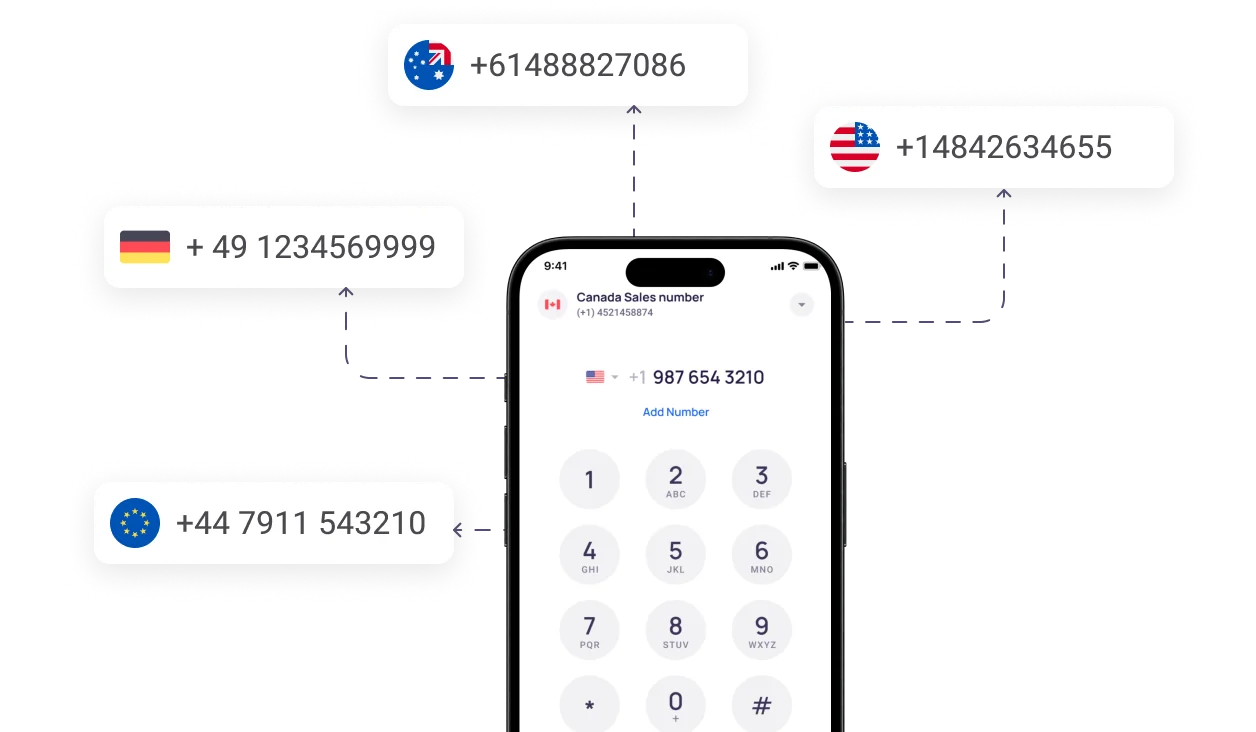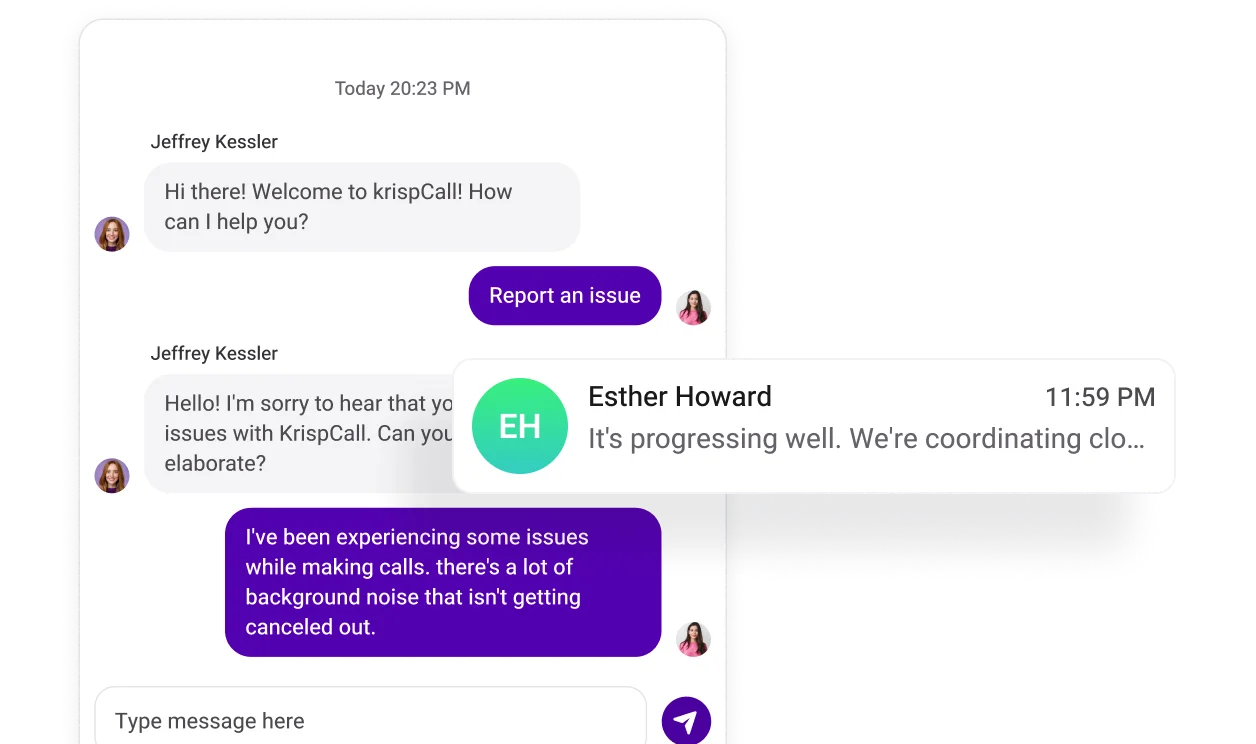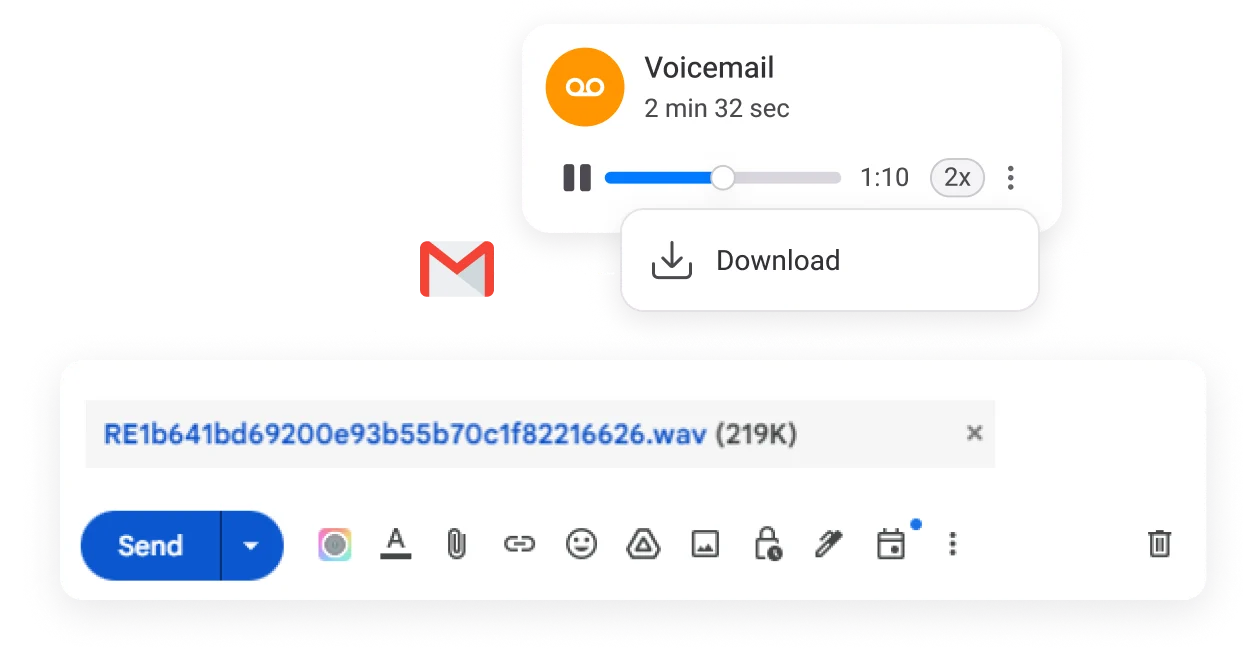Voicemail
Set up Voicemail for Improved Business Communication
Enhance your business’s communication with a professional touch by setting up KrispCall’s voicemail services. Ensure continuous communication with clients, even during off-hours, by allowing them to leave messages, fostering more efficient and efficient communication engagement.



Get a Virtual Number
Get local, mobile, and toll-free virtual phone numbers from 100+ countries and expand your business worldwide.
How to set up voicemail for my business?
To set up a voicemail for a business, first, create a KrispCall account. After that, log into KrispCall account and access ‘My Number’ settings, configure voicemail settings in the ‘Voicemail options,’ and then test the voicemail system.
- Create a KrispCall account and set up your cloud phone system.
- Login to access your account’s dashboard, go to ‘settings,’ and look for the ‘my number’ settings.
- Scroll to find the “incoming call strategy” settings, then select voicemails for unanswered calls.
- Now, move to the Greetings and Recordings section.
- Select the Voicemail option and configure, customize & personalize it.
- Make sure the voicemail system works and start using it.


What is a voicemail?
Voicemail is a telecommunications service that enables individuals to leave recorded messages for others when they are unable to answer a phone call or are simply unavailable. The messages are stored on a voicemail server, which is a telephony system that is designed to store and deliver voice messages.
Voicemail features have been a popular element of landlines, mobile phones, and cloud-based phone systems for a long time. By using it, people can leave messages for others at any time, even if the person called is not available to answer the phone immediately.
How does a voicemail work?
Voicemail is a telecommunications feature that allows for voice message recording when a call goes unanswered. It is often used when a caller dials a number, and the recipient can’t answer, or the line is inactive; the call is then directed to the voicemail system hosted by the service provider.
Once the call is directed to a voicemail system, a personalized or default greeting plays, followed by a beep signaling the caller to leave a message. The message is then recorded and stored on the server and intended users receive notifications, typically through alerts or messages, prompting them to retrieve and manage their voicemail.

Best Practices for Effective VoiceMail Messaging: The Do’s and Don’ts
Do’s
Don’t
Things to consider while Setting Up Voicemail on Your Business Phone
More Features like Voicemail
Global Calling
Expand your customer base worldwide with KrispCall global calling feature for making instant calls across borders.

Text Messages (SMS)
Ensure faster response by sending and receiving personalized text messages to and from your clients and customers.

Voicemail to Email
Receive voicemail as audio files straight to your email inbox and access it from any device without calling voicemails.

Frequently Asked Questions
Didn’t find the Answer you were looking for? Visit our Help Center or Contact Support
Ringless Voicemail (RVM), also called Voicemail Drop, is a technique that is used for marketing, spamming, or debt collection and involves delivering pre-recorded voicemails directly to voicemail inboxes without the recipient’s phone ringing.
Businesses can use voicemail for the following purposes-
- Companies can capture leads by using voicemail if potential customers call outside of business hours.
- By offering voicemail services, businesses can offer customer service by addressing questions and concerns as soon as possible.
- A contact center representative may use voicemail to screen calls before answering them, such as to screen calls from potential customers.
- Feedback can be collected from customers using voicemail.
- Promoting products and services can also be done via voicemail.
A professional business voicemail greeting should be accurate and polite. It should convey the following information:
- Be sure to clearly state your name so the caller knows who you are.
- Name of the organization or company you represent.
- Provide a brief explanation of why you are currently unavailable to answer the call.
- Let the caller know how they can reach you, such as your email address, website, or preferred time to return their call.
- You should extend your appreciation to the caller and assure them that you will respond as soon as possible.
If your phone is going straight to voicemail, then there could be several reasons behind that problem. Here are some common causes that lead to that scenario-
- Your phone is set to Do Not Disturb
- You have unintentionally enabled call forwarding
- You have blocked the caller’s number.
- The device is in Airplane mode.
- You are in a weak signal area.
- There’s an issue with your SIM Card.
- Problem with your phone’s software.
There are several factors that influence the legality of voicemail drops. Generally, voicemail drops are considered “robocalls,” which are illegal under the Telephone Consumer Protection Act (TCPA), which demands prior express consent from consumers.
However, exceptions exist for emergency notifications or other scenarios, as some countries and states have their own laws governing voicemail drops, which may be more lenient than the TCPA. If you are unsure about whether or not you can send voicemail drops, it is best to consult with your telephony service provider or concerned authorities.
A good voicemail should be informative, short, and to the point. And it should also include a CTA that indicates you will follow up with callers.
Here is an example of a good business voicemail greeting: “This is [your name] at [company name]. I’m currently away from my desk, but please leave your name, number, and a brief message, and I’ll get back to you as soon as possible. Thank you for calling.”
Voicemail systems can be divided into two types. They are as follows:
- Basic Voicemail: This is the simplest and most common type of voicemail system that allows callers to leave a message for a recipient when they are unavailable. This type typically includes features such as greetings, message storage, and message retrieval.
- Advanced Voicemail: Voicemail systems of this type offer more features and functionality than basic voicemail systems. Besides basic features, advanced voicemail includes additional features like personalized greetings and voicemail transcription.
You can leave a voicemail without making a call in a variety of ways. Among the most common methods are:
- Using your Phone’s Voicemail System: Many phone carriers like AT&T, Verizon, and T-Mobile allow you to send voice messages to other users directly from your voicemail inbox.
- Using Messaging Apps: Messaging apps like WhatsApp and Telegram often have built-in voice messaging capabilities. With these apps, you can record a voice message and send it to a contact directly through the app.
- Using a Dedicated Voicemail App: These apps offer various features, such as scheduling voicemails, customizing greetings, and tracking delivery status.
- Using a Ringless Voicemail Service: Businesses often use ringless voicemail services to reach a large number of people without disturbing them, as these services connect callers directly to voicemail, bypassing the phone ringing process.
Ringless Voicemail (RVM), also called Voicemail Drop, is a technique that is used for marketing, spamming, or debt collection and involves delivering pre-recorded voicemails directly to voicemail inboxes without the recipient’s phone ringing.
There are several factors that influence the legality of voicemail drops. Generally, voicemail drops are considered “robocalls,” which are illegal under the Telephone Consumer Protection Act (TCPA), which demands prior express consent from consumers.
However, exceptions exist for emergency notifications or other scenarios, as some countries and states have their own laws governing voicemail drops, which may be more lenient than the TCPA. If you are unsure about whether or not you can send voicemail drops, it is best to consult with your telephony service provider or concerned authorities.
Businesses can use voicemail for the following purposes-
- Companies can capture leads by using voicemail if potential customers call outside of business hours.
- By offering voicemail services, businesses can offer customer service by addressing questions and concerns as soon as possible.
- A contact center representative may use voicemail to screen calls before answering them, such as to screen calls from potential customers.
- Feedback can be collected from customers using voicemail.
- Promoting products and services can also be done via voicemail.
A good voicemail should be informative, short, and to the point. And it should also include a CTA that indicates you will follow up with callers.
Here is an example of a good business voicemail greeting: “This is [your name] at [company name]. I’m currently away from my desk, but please leave your name, number, and a brief message, and I’ll get back to you as soon as possible. Thank you for calling.”
A professional business voicemail greeting should be accurate and polite. It should convey the following information:
- Be sure to clearly state your name so the caller knows who you are.
- Name of the organization or company you represent.
- Provide a brief explanation of why you are currently unavailable to answer the call.
- Let the caller know how they can reach you, such as your email address, website, or preferred time to return their call.
- You should extend your appreciation to the caller and assure them that you will respond as soon as possible.
Voicemail systems can be divided into two types. They are as follows:
- Basic Voicemail: This is the simplest and most common type of voicemail system that allows callers to leave a message for a recipient when they are unavailable. This type typically includes features such as greetings, message storage, and message retrieval.
- Advanced Voicemail: Voicemail systems of this type offer more features and functionality than basic voicemail systems. Besides basic features, advanced voicemail includes additional features like personalized greetings and voicemail transcription.
If your phone is going straight to voicemail, then there could be several reasons behind that problem. Here are some common causes that lead to that scenario-
- Your phone is set to Do Not Disturb
- You have unintentionally enabled call forwarding
- You have blocked the caller’s number.
- The device is in Airplane mode.
- You are in a weak signal area.
- There’s an issue with your SIM Card.
- Problem with your phone’s software.
You can leave a voicemail without making a call in a variety of ways. Among the most common methods are:
- Using your Phone’s Voicemail System: Many phone carriers like AT&T, Verizon, and T-Mobile allow you to send voice messages to other users directly from your voicemail inbox.
- Using Messaging Apps: Messaging apps like WhatsApp and Telegram often have built-in voice messaging capabilities. With these apps, you can record a voice message and send it to a contact directly through the app.
- Using a Dedicated Voicemail App: These apps offer various features, such as scheduling voicemails, customizing greetings, and tracking delivery status.
- Using a Ringless Voicemail Service: Businesses often use ringless voicemail services to reach a large number of people without disturbing them, as these services connect callers directly to voicemail, bypassing the phone ringing process.